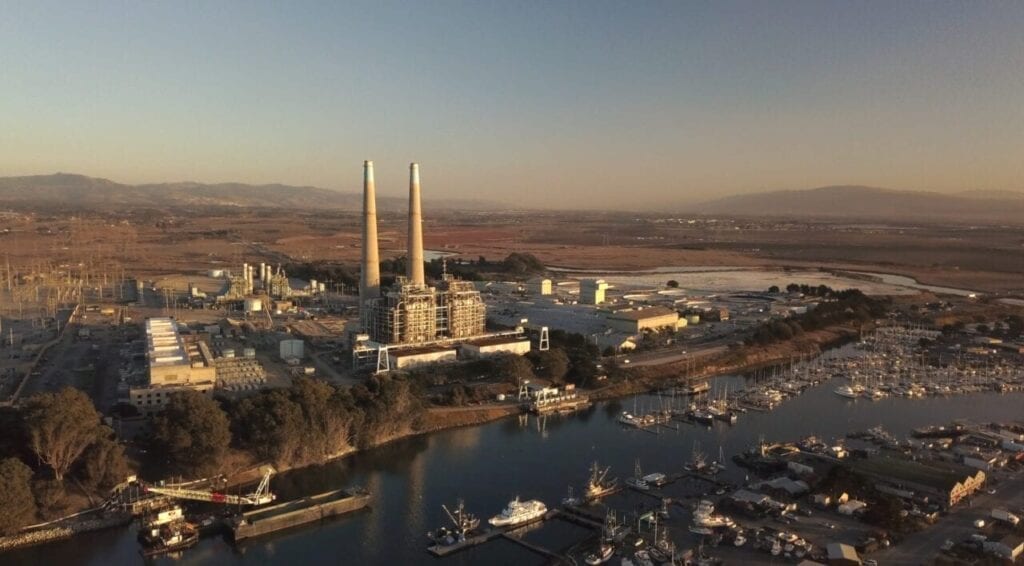Vistra Energizes Massive 1.2-GWh Battery System at California Gas Plant
Vistra Energy, the nation’s largest competitive generator, has begun operating a 300-MW/1,200-MWh lithium-ion battery storage system on its 1,020-MW combined cycle gas turbine Moss Landing power plant site in Monterey County, California. The battery storage system is the largest of its type in the world in terms of size and scale, and it towers over similar systems that have been installed to date.
Brought online on Dec. 11, the 300-MW/1,200-MWh Moss Landing Energy Storage Facility Phase 1 project is housed inside a “completely refurbished former turbine building” at the two-unit Moss Landing site, and it spans “the length of nearly three football fields,” Vistra said last week.
The system comprises more than 4,500 stacked battery racks or cabinets, each containing 22 individual battery modules. Phase II, which Vistra plans to complete by August 2021, will add an additional 100 MW/400 MWh, bringing the Moss Landing Energy Storage Facility’s total capacity to 400 MW/1,600 MWh.

A Possible Expansion to 1.5 GW/6 GWh
However, Vistra may consider expanding the project if supported by the right “market and economic conditions.” The site’s existing infrastructure and physical space can support up to 1,500 MW/6,000 MWh of storage capacity, the company said. “With the development permit already in place and the site in condition for expansion, Vistra will be able to move quickly when that time comes,” it said.
Phase I is backed by a 20-year resource adequacy contract with Pacific Gas and Electric Co. (PG&E), California’s giant investor-owned utility, which emerged from bankruptcy protection in July 2020. While the California Public Utilities Commission (CPUC) approved the contract for Phase I in November 2018, a bankruptcy court approved PG&E’s motion requesting assumption of the contract in November 2019, and the CPUC gave its approval to an amendment to the resource adequacy contract in January 2020.
The 100-MW/400-MWh Phase II is backed by a 10-year resource adequacy contract with PG&E, which the CPUC approved in August 2020. Under the long-term contracts, “PG&E will pay us a fixed monthly resource adequacy payment, while we will receive the energy revenues and incur the costs from dispatching and charging the [energy storage system (ESS)],” Vistra explained.
Energy Storage as a Peaker
Phase I essentially acts in a peaking capacity, capturing “excess electricity from the grid, largely during high solar-output hours, and can release the power when energy demand is at its highest and solar electricity is declining, usually early morning and late afternoon,” Vistra said.
That falls in line with a trend noted by Sandia National Laboratories in a recent issue brief. Over the last decade, renewable energy and ESSs have been encouraged through procurement mandates or financial incentives set at the state level, and have emerged as a competitive alternative to existing or planned peaker plants, Sandia said.
Citing a June 2019 National Renewable Energy Laboratory study, Will McNamara, Sandia Grid Energy Storage policy analyst, noted about 150 GW of the nation’s 261-GW peaking fleet “is likely to retire over the next 20 years, creating the potential for about 28 GW of 4-hour battery storage that could serve as peaking capacity.”
McNamara also noted that owing to a steady decline in the cost of power from batteries over the last decade—the cost for a standalone ESS now averages about $209/kWh, he said—the cost of using a state-of-the-art ESS is “extremely competitive compared to running a fossil fuel peaker plant.”
Beyond the cost advantage, “batteries have much faster response time—they can virtually ramp up and down instantly by following signals from the grid operator. Gas peakers can barely match the flexibility and responsiveness time of batteries,” he said. Still, not all existing peaker plants in the U.S. can be easily replaced with ESSs owing to duration limitations. “ESSs remain a finite asset with limited duration capability, while peaker plants fueled by natural gas can run for significantly longer durations,” he said.
In California, a state that has set a goal to source 100% of its power from clean energy by 2045 but which suffered a debilitating reliability crisis last August, nearly 80 natural gas-fired peaker plants are used to help address statewide peak demand, said McNamara. “These plants include 65 combustion turbines designed to ramp quickly and over ten aging steam and combined cycle turbines (now used infrequently),” he said.
California has so far enacted a number of policies and incentives that could “both directly and indirectly facilitate the replacement of peakers with solar and storage,” he said. These include a procurement mandate of 1.8 GW of energy storage, 500 MW of which must be from behind-the-meter applications. State rules also require that ESSs with four hours of continuous discharge capability are eligible to meet the state’s resource adequacy requirements. In March 2020, the CPUC also adopted a proposed decision that identifies a specific statewide need for 1 GW of long-duration energy storage by 2026.
In November 2018, notably, the CPUC approved PG&E’s ambitious proposal to replace three aging natural gas peakers owned by Calpine—the 580-MW Metcalf plant, and the Feather River and Yuba City generators, both 48 MW—with four energy storage projects: Vistra’s 300-MW/1,200-MWh Moss Landing Phase I; a 75-MW/300-MWh facility from Hummingbird Energy Solutions; a 10-MW/40-MWh facility from battery provider mNOC; and a a 182.5-MW/730-MWh project from Tesla. PG&E and Tesla began construction on the 182.5-MW lithium-ion battery system at PG&E’s electric substation in Moss Landing in Monterey County in July 2020. That project is slated to be energized early this year and fully operational in the second quarter of 2021.
Vistra CEO Curt Morgan appears optimistic about prospects to expand Moss Landing. “We think over time, because of the value of that site, and because of the need for batteries, given the substantial amount of solar in [California], it’s a perfect opportunity to work together with the state of California, with PG&E, and Vistra, hand-in-glove, to build out so that the people of California receive the electricity that they need and there are no interruptions in that electricity service,” he said last week.

A Mammoth Battery Storage Installation
When completed, the 400-MW/1,600-MWh facility will be the biggest of Vistra’s four energy storage projects. The company, which in September said it would target net-zero carbon emissions by 2050, is also notably developing the 260-MW/260-MWh DeCordova Energy Storage Facility in Hood County, Texas, a project that will compete within the Electric Reliability Council of Texas when it comes online in 2022.
According to the National Technology & Engineering Sciences of Sandia’s (NTESS’s) Global Energy Storage Database, only one planned project—Recurrent Energy’s 490-MW Crimson solar-storage project—could be bigger, but the status of the storage component, announced in 2016, is unclear. The database also notes that in 2019, NV Energy garnered Nevada’s approval to build the Gemini Solar + Battery Storage Project, a 690-MW solar PV array coupled with a 380-MWAC battery storage system. That project, located on about 7,100 acres of federally owned land in Clark County, is slated to come online in January 2024.
However, the database, last updated in November, does not record a number of projects that have recently claimed to be “the world’s largest” battery storage facilities. Among notable operational projects are LS Power’s 250-MW/250-MWh Gateway Energy Storage facility in San Diego County, California, which was energized in August 2020. Before Gateway came online, the Tesla-supplied Hornsdale plant (150 MW/193.5 MWh) in South Australia was thought to be the largest facility of its kind.
Other contenders include Australian firm Origin Energy, which is looking to build a 700-MW/2,800-MWh battery storage system at the company’s only coal power plant, Eraring Power Station in New South Wales (NSW). On Jan. 12, the company said it lodged an interconnection request with grid entity TransGrid to connect the battery to the national grid. “The deployment of this battery at Eraring will support Origin’s orderly transition away from coal-fired generation by 2032, while complementing the policy objectives of the NSW energy roadmap,” said Origin Executive General Manager, Energy Supply and Operations, Greg Jarvis.
In December, U.S.-based Invinity Energy Systems told POWER it is building “the world’s largest solar-powered flow battery” in Yadlamalka, South Australia. The AU$20 million project entails installation of an 8-MWh Vanadium Flow Battery (VFB) system supplied by Invinity that will be installed alongside a 6-MWp solar PV array to provide power to the local grid on demand this year. VFBs, first reportedly developed at the University of New South Wales in the 1980s, have garnered much interest because they are larger and more durable than lithium-ion batteries.
Even if it loses its status as the largest facility of its kind, Moss Landing Phase I will remain relevant for pioneering an innovative and competitive project, said Vistra’s Morgan. “This is a keystone project and it is important in so many ways—it revitalizes an existing power plant site and utilizes active transmission lines, enhances grid stability, fills the reliability gap created by intermittent renewables, provides emission-free electricity, supports California’s sustainability goals and mandates, significantly benefits the local community, and ultimately provides affordable electricity to consumers,” he said.
“A battery system of this size and scale has never been built before. As our country transitions to a clean energy future, batteries will play a pivotal role and the Vistra Moss Landing project will serve as the model for utility-scale battery storage for years to come.”
—Sonal Patel is a POWER senior associate editor (@sonalcpatel, @POWERmagazine).